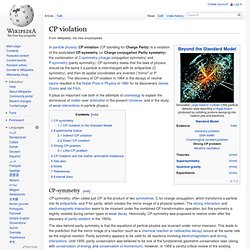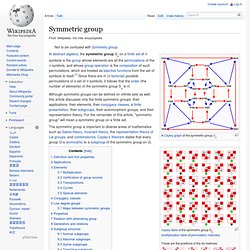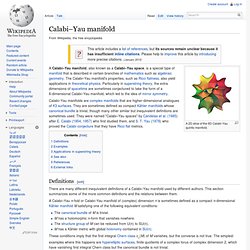

CP violation. It plays an important role both in the attempts of cosmology to explain the dominance of matter over antimatter in the present Universe, and in the study of weak interactions in particle physics.

CP-symmetry[edit] The idea behind parity symmetry is that the equations of particle physics are invariant under mirror inversion. This leads to the prediction that the mirror image of a reaction (such as a chemical reaction or radioactive decay) occurs at the same rate as the original reaction. Parity symmetry appears to be valid for all reactions involving electromagnetism and strong interactions. Until 1956, parity conservation was believed to be one of the fundamental geometric conservation laws (along with conservation of energy and conservation of momentum). Overall, the symmetry of a quantum mechanical system can be restored if another symmetry S can be found such that the combined symmetry PS remains unbroken.
CP violation in the Standard Model[edit] and , and their antiparticles . . . . January 2009. Symmetric group. Although symmetric groups can be defined on infinite sets as well, this article discusses only the finite symmetric groups: their applications, their elements, their conjugacy classes, a finite presentation, their subgroups, their automorphism groups, and their representation theory.

For the remainder of this article, "symmetric group" will mean a symmetric group on a finite set. The symmetric group is important to diverse areas of mathematics such as Galois theory, invariant theory, the representation theory of Lie groups, and combinatorics. Cayley's theorem states that every group G is isomorphic to a subgroup of the symmetric group on G.
Definition and first properties[edit] The symmetric group on a finite set X is the group whose elements are all bijective functions from X to X and whose group operation is that of function composition.[1] For finite sets, "permutations" and "bijective functions" refer to the same operation, namely rearrangement. Applications[edit] Elements[edit] Sym(2) Symmetry (physics) Calabi–Yau manifold. A 2D slice of the 6D Calabi-Yau quintic manifold.

Calabi–Yau manifolds are complex manifolds that are higher-dimensional analogues of K3 surfaces. They are sometimes defined as compact Kähler manifolds whose canonical bundle is trivial, though many other similar but inequivalent definitions are sometimes used. They were named "Calabi–Yau spaces" by Candelas et al. (1985) after E. Calabi (1954, 1957) who first studied them, and S. T. Definitions[edit] There are many different inequivalent definitions of a Calabi–Yau manifold used by different authors. A Calabi–Yau n-fold or Calabi–Yau manifold of (complex) dimension n is sometimes defined as a compact n-dimensional Kähler manifold M satisfying one of the following equivalent conditions: These conditions imply that the first integral Chern class c1(M) of M vanishes, but the converse is not true.
Membrane (M-theory) In string theory and related theories, D-branes are an important class of branes that arise when one considers open strings.

As an open string propagates through spacetime, its endpoints are required to lie on a D-brane. The letter "D" in D-brane refers to the fact that we impose a certain mathematical condition on the system known as the Dirichlet boundary condition. The Lattice A15+ Cyclic model. A cyclic model (or oscillating model) is any of several cosmological models in which the universe follows infinite, or indefinite, self-sustaining cycles.

For example, the oscillating universe theory briefly considered by Albert Einstein in 1930 theorized a universe following an eternal series of oscillations, each beginning with a big bang and ending with a big crunch; in the interim, the universe would expand for a period of time before the gravitational attraction of matter causes it to collapse back in and undergo a bounce. Overview[edit] In the 1920s, theoretical physicists, most notably Albert Einstein, considered the possibility of a cyclic model for the universe as an (everlasting) alternative to the model of an expanding universe.
However, work by Richard C. Tolman in 1934 showed that these early attempts failed because of the cyclic problem: according to the Second Law of Thermodynamics, entropy can only increase.[1] This implies that successive cycles grow longer and larger. M-theory. M-theory is a theory in physics that unifies all consistent versions of superstring theory.

The existence of such a theory was first conjectured by Edward Witten at the string theory conference at the University of Southern California in the summer of 1995. Witten's announcement initiated a flurry of research activity known as the second superstring revolution. Background[edit] Quantum gravity and strings[edit]